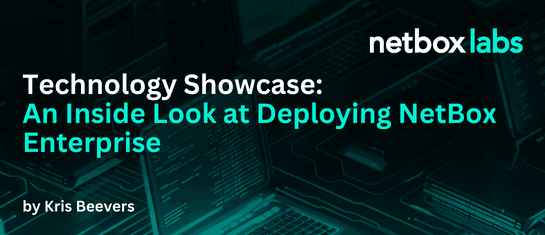Technology Showcase: An Inside Look at Deploying NetBox Enterprise

It’s been a few months since we announced NetBox Enterprise, the enterprise-grade, self-managed edition of NetBox that offers additional features beyond the Community edition and expert support from NetBox Labs. Already, NetBox Enterprise is a huge hit and we’re thrilled to have brought a wide array of customers on board, ranging from government agencies and global financial institutions to massive software companies and high growth startups. NetBox Enterprise is quickly becoming the NetBox edition of choice for organizations that need more than community features and support, but can’t yet take advantage of NetBox Cloud – often for regulatory or policy reasons.
NetBox Enterprise makes it easy to self-manage NetBox
A major differentiation of the NetBox Enterprise edition is a distribution model that makes it the easiest way to manage the installation and ongoing operation of a complete, modern NetBox stack in your own environment. NetBox Enterprise is delivered in an all-in-one distribution that packages up all the key components and dependencies of a self-managed NetBox deployment, tremendously simplifying the process of deploying, configuring, scaling, and updating the whole environment. Deploying NetBox in mission-critical production environments isn’t as simple as it seems because NetBox leverages underlying components – databases, caching layers, application environments, and web servers – all of which need to connect and work together seamlessly. As NetBox Labs and the NetBox community have worked together to rapidly expand the functionality in NetBox and the surrounding ecosystem, NetBox environments have become even more complex. For example, managing plugins, configuring authentication integrations with SSO or SAML, and connecting next-gen components like Diode all introduce new operational challenges.
NetBox Enterprise makes managing all these dimensions easy, with wizard-like installations for multiple types of environments, one-click upgrades, and full support by the team at NetBox Labs. In this blog, we’ll dive into some of the options for NetBox Enterprise deployments and do a deep dive into an installation of NetBox Enterprise in a modern Kubernetes environment.
Multiple deployment models to suit your environment
NetBox Enterprise supports different deployment models to best address varying requirements and environments. For a fully managed, hands-off experience, we support an Embedded Cluster (EC) installation that takes care of everything, including deploying and managing the underlying Kubernetes cluster. All that’s needed is a bare Linux operating system running on adequately sized compute resources. EC deployments deliver all the components and dependencies required to install and operate NetBox, including databases, application servers, application load balancers, and object stores. EC deployments also provide the option of leveraging external components, such as a cloud PostgreSQL cluster or an S3 Object Store.
For customers who are already operating their own Kubernetes clusters, we also support a Kubernetes Off-The-Shelf (KOTS) installation that deploys NetBox Enterprise on your k8s cluster. KOTS deployments include all the same components and take care of all the dependencies just like EC deployments. They also provide the same flexibility in leveraging external database and object store components.
Walking through a fully contained NetBox Enterprise installation
Let’s walk through an Embedded Cluster (EC) install to see just how easy it is to get started with NetBox Enterprise!
Step 1 – Download the deployment package and license file to your Linux host:
curl https://replicated.app/embedded/netbox-enterprise/stable -o netbox-enterprise-stable.tgz |
Step 2 – After uncompressing the package, simply launch the installation:
sudo ./netbox-enterprise install --license license.yaml |
You’ll be requested to create a password for the NetBox Enterprise admin console and the cluster will be deployed, ready to host all the NetBox application components. The deployment of the cluster is complete when you see this message:
Visit the Admin Console to configure and install netbox-enterprise: http://my.netbox-enterprise.host:30000 |
Step 3 – Access the NetBox Enterprise admin console and configure NetBox
Open the provided URL in your browser. You’ll be prompted for the password you created in Step 2:
You’ll then be guided to configure NetBox for your environment:
You’ll be able to configure:
- Version of NetBox that you want to install
- Whether to use a built-in or external PostgreSQL
- Whether to use a built-in or external S3-Compatible object store
- And finally, advanced settings to configure plugins and SSO remote authentication
The deployment of NetBox Enterprise will then proceed:
The “Unavailable” status will change to “Ready” once the deployment is complete and NetBox has fully initialized:
Step 4 – That’s it! You’re ready to get started with NetBox
Simplify your NetBox deployment with NetBox Enterprise
Today, we’ve taken a look at installing and operating a fully contained NetBox Enterprise Embedded Cluster deployment – one of several options for deploying NetBox Enterprise. If you need to deploy NetBox in your own environment, then self-managed NetBox Enterprise is a great option that makes installing and running NetBox easy, and of course gets you access to advanced features and support from NetBox Labs.
Want to try it out? Contact us to talk about NetBox Enterprise today!
